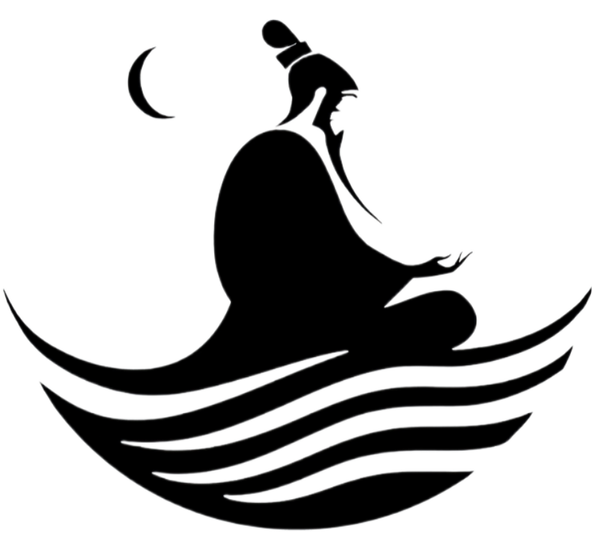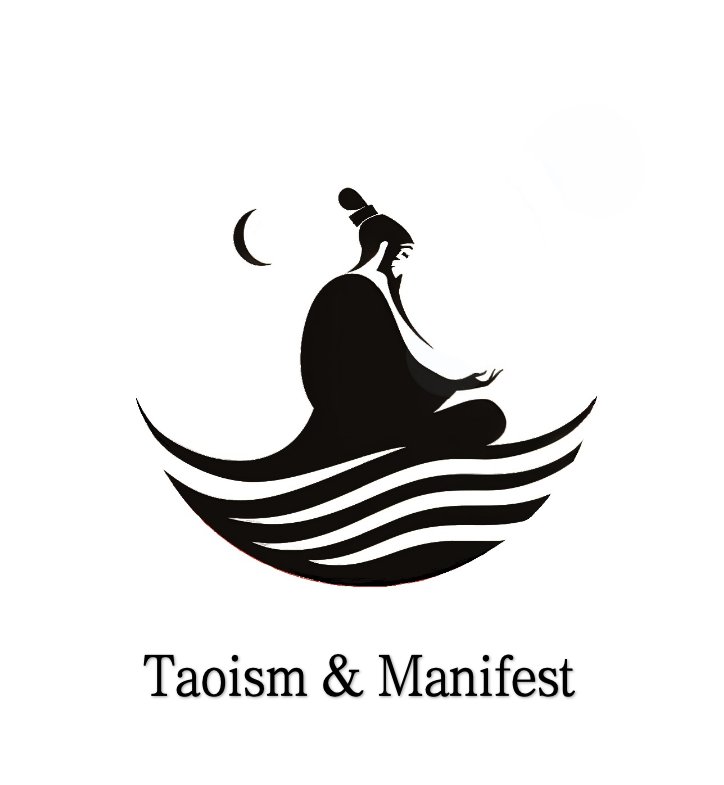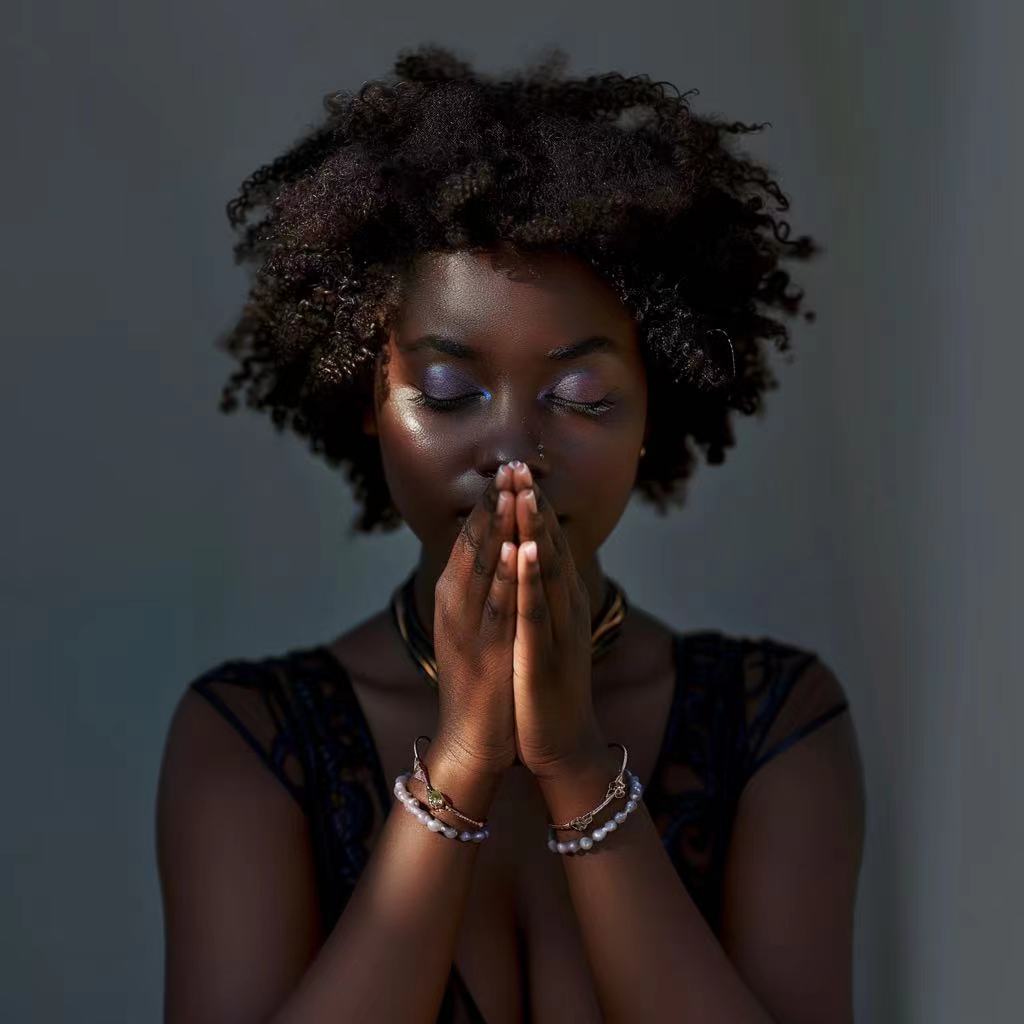
You can see prayer beads in many religions around the world. These beads help people meditate and pray every day. They help you focus and feel close to the divine.
Prayer beads stand for protection, peace, and thankfulness in many cultures.
Christianity
Hinduism
Buddhism
Shinto
Sikhism
Baháʼí Faith
Islam
People use prayer beads to count prayers. They also use them to think about holy mysteries. Prayer beads help people show thanks during spiritual times.
Key Takeaways
Prayer beads help you pay attention during meditation and prayer. They let you count prayers and keep your mind on what you are doing.
Many religions use prayer beads in different ways. Each kind of bead has its own special meaning and importance.
Using prayer beads can help you feel calm and less stressed. Touching and moving the beads helps you relax and think.
Prayer beads link you to a long history of faith. They remind you of what you believe and help you feel part of a bigger group.
You can use prayer beads even if you do not follow a religion. They are good tools for being mindful and growing as a person.
Prayer Beads Symbolism
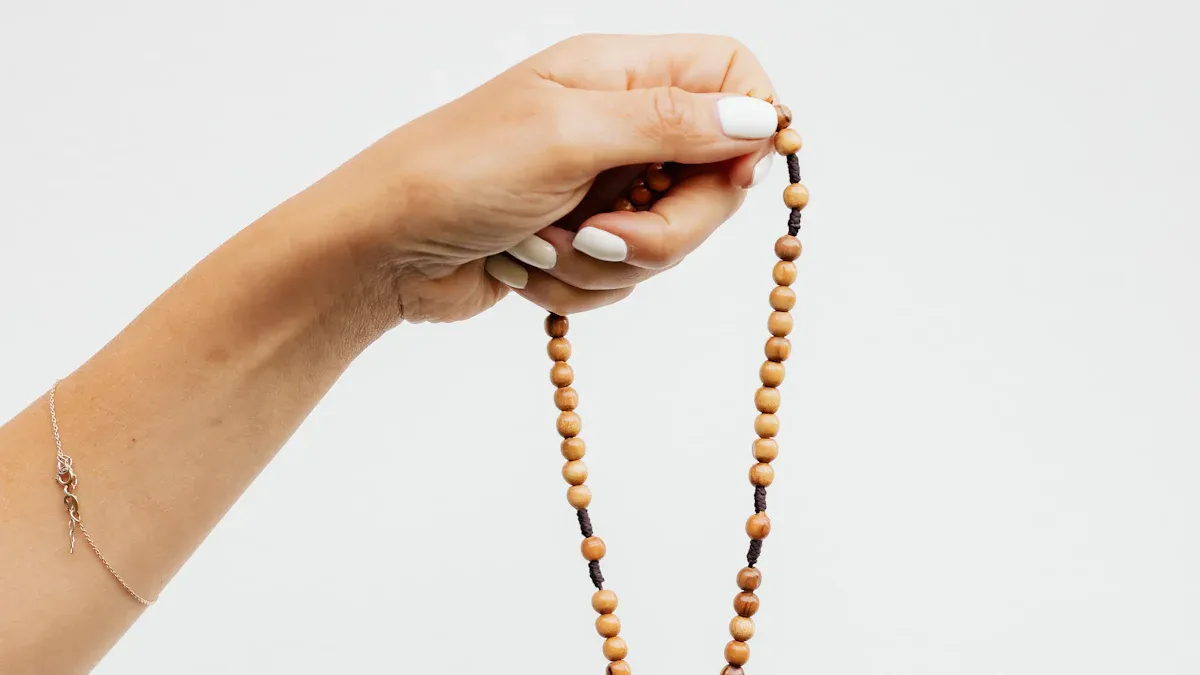
Spiritual Meaning
Prayer beads have a special meaning in many religions. When you use them, you join a worldwide tradition. These beads help you focus during meditation or prayer. You can find prayer beads in Christianity, Buddhism, Hinduism, Sikhism, and Islam. Each religion gives the beads its own meaning. But all use them to help people connect with the divine.
The word "bead" comes from the Sanskrit word "buddh," which means "to awaken." This shows that prayer beads are a sign of spiritual awakening and a link to something greater.
When you pray with beads, you often repeat prayers or mantras. Doing this helps you stay focused and aware. It also helps you think about yourself and feel calm. Many people believe prayer beads stand for faith and inner peace. They also see them as a way to show thanks and feel connected to others. (To learn more about how prayer beads enhance meditation focus, check out our article: How Prayer Beads Enhance Focus and Mindfulness in Meditation.)
Here is a table that shows how different religions use prayer beads and what they mean:
Religion/Tradition |
Prayer Bead Type |
Symbolic Meaning |
|---|---|---|
Christianity |
Dominican rosary |
Structured devotion |
Eastern Orthodox |
Chotki/prayer rope |
Personal spirituality |
Buddhism/Hinduism |
Japamala |
Mindfulness and meditation |
Sikhism |
Jaap Sahib |
Discipline and closeness to God |
Islam |
Misbaha |
Mindfulness and structured devotion |
General |
Blessing beads |
Interconnectedness and gratitude |
Praying with beads helps you focus and count your prayers. Moving from bead to bead keeps your mind from wandering. It also helps you feel closer to your beliefs. If you want to know more about prayer beads, you can visit Wikipedia's article on prayer beads.
Protection and Peace
Prayer beads also stand for protection and peace. Many people think that using prayer beads keeps away bad energy. When you hold the beads, you may feel calm and safe. This feeling comes from holding the beads and their spiritual meaning.
Praying with beads can help you feel peaceful when you are stressed. Each bead marks a prayer or a time to think. As you move through the beads, you slow down and focus on now. This can help you feel calm and let go of worries.
Prayer beads help you meditate and focus your thoughts.
Each bead can stand for a prayer or a time to reflect, making your spiritual time deeper.
Using prayer beads helps you be mindful and strengthens your faith.
Across cultures, prayer beads have some things in common:
Similarity |
Description |
|---|---|
Counting Aid |
All help you count prayers or mantras |
Focus |
Help you keep your mind on prayer or meditation |
Portability |
Easy to carry and use anywhere |
Symbolism |
Have special spiritual meaning |
You can use prayer beads during rituals or big life events. Some people use them at weddings, funerals, or special ceremonies. In these times, prayer and beads give comfort and support. The meaning of prayer beads reminds you that you are not alone. They help you feel safe and peaceful wherever you are.
History of Prayer Beads
Early Origins
Prayer beads have been used for a very long time. Ancient people did not just use beads for decoration. Archaeologists found beads made from shells in Blombos Cave. These beads are about 75,000 years old. They show that beads were used for rituals and social identity. Some places have shell beads from 120,000 years ago. This means beads were important in ceremonies or as symbols.
People made beads from things like ostrich eggshell and bone. These materials show beads meant more than just looking nice. Beads may have had spiritual meaning for ancient people.
Early Christians, called Desert Fathers and Mothers, lived in deserts in the 3rd century. They wanted to grow closer to God. At first, they counted prayers with pebbles. They dropped a pebble in the sand for each prayer. Later, they used stones or seeds on cords. This made counting prayers easier.
The Desert Fathers carried pebbles in small bags. Over time, they started using ropes with knots. These ropes helped them count prayers like the Jesus Prayer. This was a big change for prayer beads. The practice became more organized and special. (If you're curious about the detailed history of prayer beads, read our article: What Is the History Behind Prayer Beads.)
Prayer beads started as simple tools for counting prayers. Over many years, they became symbols of faith and discipline.
Evolution Across Religions
Prayer beads changed as different cultures and religions used them. The tradition began in India with Hinduism. People used beads to count prayers and mantras. Buddhism later used prayer beads called malas. The practice spread to the Middle East, China, and Japan. Each place made the beads fit their own customs.
Here is a table with important moments in prayer bead history:
Milestone |
Description |
|---|---|
10,000 BC |
Ostrich shell beads found in Africa, showing early use for decoration and spiritual reasons. |
500 BC |
First written record of prayer beads from India, marking their use in Hinduism. |
1600 BC |
Greek painting shows people with bead strings, highlighting their presence in ancient Greece. |
1569 |
Catholic Church officially recognizes the rosary, a major step in Christian prayer bead history. |
2002 |
Pope John Paul II adds the Luminous Mysteries to the rosary, showing ongoing change in Christianity. |
Prayer beads moved from one religion to another. Hinduism started using prayer beads first. Buddhism used them later and spread the tradition. The beads traveled to the Middle East, China, and Japan. Each culture changed the beads to match their beliefs.
Different religions made their own kinds of prayer beads. Here is a table showing how they are different:
Religion/Region |
Type of Prayer Beads |
Characteristics and Uses |
|---|---|---|
Christianity |
Rosary |
Used for prayer sequences, often with a cross and special prayers. |
Buddhism |
Japa Malas, Juzu |
Used for counting mantras, usually 27 or 108 beads. |
Hinduism |
Mala |
Used for counting prayers, often made from rudraksha or tulsi seeds. |
Islam |
Misbahah |
Has 99 beads for saying the names of God. |
Sikhism |
Mala |
Used for meditation and saying God's name. |
Bahá'í Faith |
Prayer Beads |
Used for meditation and prayer, with special designs. |
Prayer beads started in India with Hinduism.
Buddhism used prayer beads and spread the idea.
The beads went to the Middle East, China, and Japan.
Each place made the beads fit their own beliefs.
Today, people use prayer beads for meditation and mindfulness. You can count beads or say mantras to help you focus. Some people pick gemstone beads for healing. Others use worry beads to feel less anxious. Prayer beads are still important in many cultures. (Learn more about the differences between Buddhist and Hindu prayer beads in our article: Prayer Beads vs. Mala Beads: Differences and Similarities.)
Bead Meaning in Prayer
Etymology
You might wonder where the word "bead" comes from. The term began in the mid-14th century as "bede," which meant "prayer bead." People used it to describe the beads they held while praying. The word comes from Old English "gebed," which means "prayer." It also connects to Proto-Germanic "bidam," meaning "entreaty." This history shows that beads have always had a link to the practice of praying. When you use prayer beads, you join a tradition that goes back hundreds of years.
The word "bead" started as "bede," meaning "prayer bead."
Old English "gebed" means "prayer."
Proto-Germanic "bidam" means "entreaty."
The word's history shows its connection to the practice of praying and counting prayers.
If you want to learn more about the history of prayer beads, you can visit our Taoism and meditation tools guide.
Counting and Reflection
When you use prayer beads, you do more than count. You take part in a practice that helps you focus and reflect. Many faiths use beads to count repetitions of sacred phrases. This practice of praying helps you stay focused. The beads give you a tactile experience. Your fingers move from bead to bead, which engages your senses and helps you concentrate. The rhythmic movement creates a calming effect. You enter a meditative state and let go of stress.
Studies show that using prayer beads can activate relaxation responses in your brain. Your heart rate and cortisol levels drop. You feel less anxious and more peaceful. Some people report better sleep and lower blood pressure after using prayer beads daily. The practice of praying with beads helps shift your body from "fight or flight" to "rest and digest." You feel calm and ready to heal.
Different faiths use special beads and materials. Each type has its own meaning. Here is a table that shows some examples:
Bead Type |
Symbolism |
Material Examples |
|---|---|---|
Guru Bead |
Spiritual teacher or guide |
N/A |
Bodhi Seeds |
Enlightenment |
Bodhi seeds |
Rudraksha |
Calmness |
Rudraksha |
Sandalwood |
Purification |
Sandalwood |
Lotus Seeds |
Spiritual growth |
Lotus seeds |
Gemstones |
Healing |
Gemstones |
Bone |
Impermanence |
Bone |
Colors |
Symbolic meanings |
White, Red, Green, etc. |
Finger Placement |
Symbolic meanings of fingers |
Thumb, Index Finger |
You can use prayer beads as tools for meditation. The practice helps you reflect on your thoughts and feelings. You can find more about the practice of praying and meditation in our Tao Te Ching reflection series.
Prayer Beads in Religions
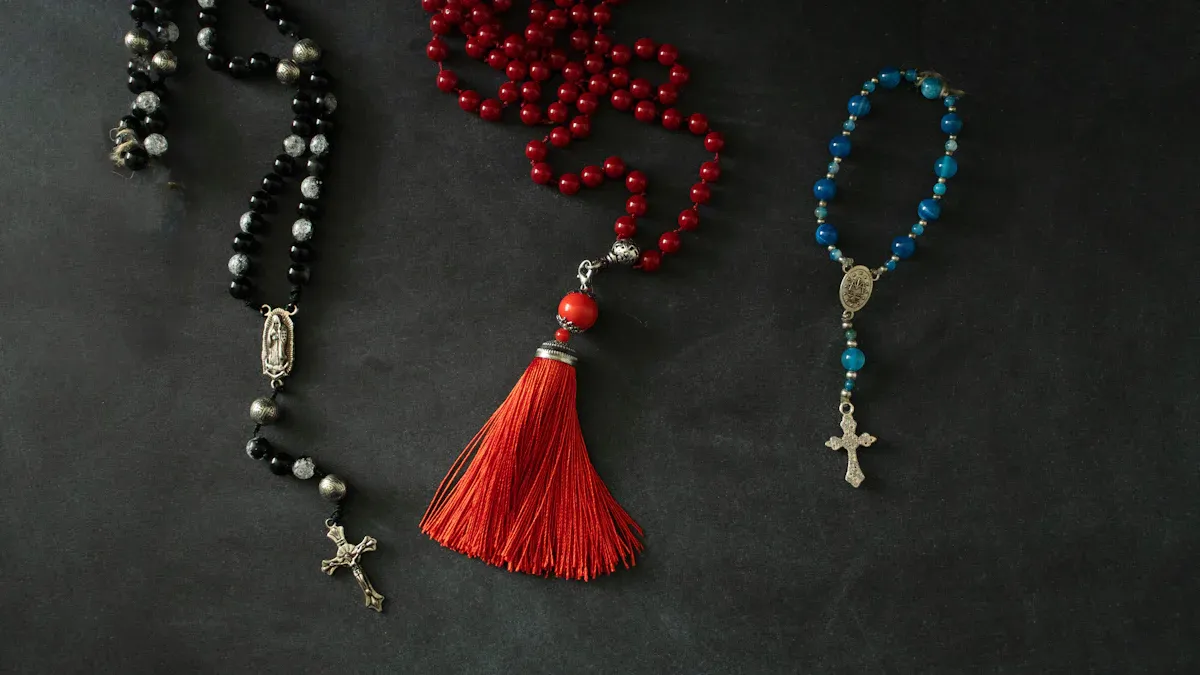
Christianity and Rosary
The rosary is very important in Catholic prayer. It helps you think about Jesus and Mary’s lives. You move through beads as you pray. Each bead helps you remember a prayer or mystery. Saint Dominic made the rosary popular in the 1200s. He wanted people to use it to fight wrong beliefs. In 1571, Pope Pius V asked people to pray the rosary during a big battle. Many believe this helped them win. The rosary mixes love for Mary with thinking about Jesus. You can reflect on Jesus’ life through Mary’s view. Using the rosary brings you closer to Jesus and Mary. Praying with others makes you feel part of the Catholic group.
The rosary gives Christians strength and peace. It helps you get closer to Jesus and Mary. It also helps you share peace with others.
Different Christian groups use prayer beads in their own ways:
Catholic rosary: Helps you think about Jesus and Mary’s stories, often with others.
Orthodox prayer rope: Used for the Jesus Prayer, helping you pray and think alone.
Buddhism and Mala
Buddhists use mala beads to count mantras when they meditate. Mala beads help you keep your mind on your practice. They help you stay focused and present. Mala beads also help you grow spiritually and change for the better. You can set a goal or wish as you touch each bead.
Role of Mala Beads |
Description |
|---|---|
Counting Mantras |
Helps you keep track of mantras. |
Aiding Concentration |
Makes it easier to focus while meditating. |
Enhancing Spiritual Connection |
Helps you feel closer to your spiritual path. |
Promoting Personal Growth |
Supports you as you learn about yourself. |
Setting Intentions |
Lets you put your hopes and goals into the beads. |
Mala beads are made from many things like teak, bone, sandalwood, rosewood, lava stone, lotus seed, and bodhi seed. Each material means something special, like purity or wisdom. You can read more about Buddhist meditation tools at Taoist and Manifest’s guide to meditation tools.
Islam and Misbaha
Muslims use misbaha, also called tasbih, to count prayers during dhikr. Dhikr means remembering God. You use misbaha to repeat words or names of Allah. The beads help you focus and think about God’s traits. Most misbaha have 33 or 99 beads. Each bead stands for one of Allah’s 99 names. This helps you remember and think about God’s qualities.
Number of Beads |
Significance |
|---|---|
33 |
Used for short prayers, saying SubhanAllah, Alhamdulillah, and Allahu Akbar 33 times after praying. |
99 |
Each bead stands for a name of Allah, helping you think about His traits. |
Moving through the beads helps you feel calm and focused. The touch and rhythm make your worship feel real. Misbaha helps you connect with your faith and pay attention during prayer.
Hinduism and Japa Mala
In Hinduism, you use japa mala to repeat mantras or holy names. This is called japa. You can say the mantra out loud, whisper it, or say it in your mind. You hold the mala in your right hand. You move each bead with your thumb. You do not use your index finger because it stands for ego. Japa mala helps you relax, focus, and build good energy. It also helps you learn about yourself.
Japa means repeating a mantra out loud, in a whisper, or silently.
You use your right hand and do not use your index finger to keep your practice pure.
Japa mala helps you control your thoughts and connect with higher truths.
Japa mala has been used in Hindu art and culture for a long time. People in India started using it to count prayers. Later, other places used it too. You can learn more about japa mala and spiritual practice in Hinduism at Taoist and Manifest’s reflection series.
Modern Symbolism
Contemporary Spirituality
Prayer beads have new meanings today. People use them for more than religion. They help with mindfulness and personal growth. Some artists make prayer beads into home decorations. For example, the misbah is now a fancy item. It uses semi-precious stones and marble beads. Afghan craftspeople and UAE artisans work together to make these. The beads can be very long, from three to eight meters. They often have geometric shapes from Emirati designs.
Item |
Purpose |
Collaboration |
Materials |
Size |
Design Inspiration |
|---|---|---|---|---|---|
misbah reinterpretation |
Sculptural home accessory |
Afghan craftspeople & UAE-based craftswomen |
Semi-precious stone, marble beads |
3–8 meters long |
Geometric Emirati patterns |
There are new types like the Anthropocenic Rosary. This rosary uses short sayings and facts about the Anthropocene. It does not use old prayers. It helps you think about changes in the world. You look at things from a geophysical and whole-world view.
Item |
Purpose |
Content |
Worldview |
|---|---|---|---|
The Anthropocenic Rosary |
Informational passages about Anthropocene |
Short invocations |
Geophysical, holistic |
Prayer beads help people focus during repeated prayers. Many say this brings calm and mindfulness. People feel relaxed, peaceful, and close to God. Moving the beads in your hands helps you feel calm. It helps you connect with your deeper self. Some people feel less proud and more humble. They also feel less alone and more part of a group. (Discover how modern prayer tools adapt to contemporary life in our article: Discover the Minimalist Travel through Taoist Wisdom)
Ongoing Relevance
Prayer beads are still popular today. You see them in yoga studios and meditation groups. People also use them as special spiritual items. More people want things that help with mindfulness and meditation. Prayer beads help people feel better and steady in life. They may trust God more and feel guided. Many say they feel part of a group and see changes in themselves.
Mixing old traditions with new wellness ideas
More people want personal spiritual items
You can learn more about meditation and spiritual tools in our Taoism meditation tools guide. Prayer beads show that old traditions can change and still matter today.
You learn that prayer beads have strong spiritual meaning. They help people find peace inside themselves. Many people say prayer beads help you pay attention. They make you slow down and think clearly.
Touching the beads helps you stay in the moment.
Counting or repeating prayers makes you feel calm. It helps you meditate better.
Prayer beads link you to old traditions. They help you with your spiritual path now. People still use them to find calm and focus as they look for peace.
FAQ
What do prayer beads symbolize in different religions?
Prayer beads symbolize faith, mindfulness, and spiritual connection. You use them to focus your mind and count prayers. In Christianity, they represent devotion. In Buddhism and Hinduism, they help with meditation. In Islam, they remind you of God's names.
Can you use prayer beads if you are not religious?
You can use prayer beads for meditation or relaxation. Many people use them to calm their minds or reduce stress. You do not need to follow a religion to benefit from their soothing effect.
How do you choose the right prayer beads for yourself?
You can pick prayer beads based on material, size, or tradition. Some people choose beads made from wood, seeds, or gemstones. You may select beads that feel comfortable or match your spiritual goals.
Do prayer beads have a connection to Taoism or Qi?
Prayer beads do not play a central role in Taoism. You may find meditation tools in Taoist practice, but beads are rare. Qi refers to life energy in Taoism. Prayer beads do not directly relate to Qi or Tao Te Ching teachings.
See Also
How Prayer Beads Enhance Focus and Mindfulness in Meditation
What Is the History Behind Prayer Beads.
